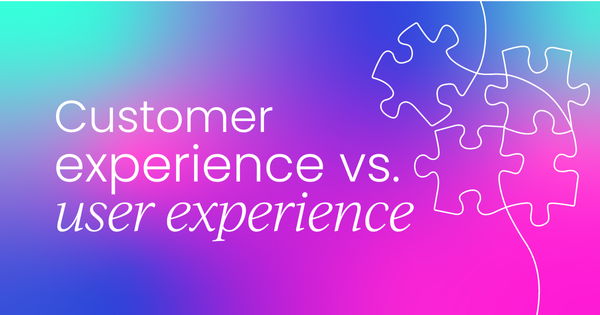Customer experience (CX) and user experience (UX) are two facets of the overall interaction and engagement customers and users have with a brand or product. Sure, both of these terms sound like they’re cut from the same cloth, but they’re interestingly pretty distinct.
Did you know 86% of buyers are willing to pay more for a great customer experience? And that for every $1 invested in UX, companies see a return of $100 – that’s an ROI of 9.9K%!
You might feel like knowing these definitions will only take you so far; isn’t it just a straightforward case of X=1, Y=2? Understanding the distinction between CX and UX is crucial for business success because being able to differentiate between the two puts your business leagues ahead of its competitors. It allows businesses to deeply understand their customers' needs and preferences, and deliver an experience that meets and exceeds their expectations across all touchpoints.
In this article, we’re going to shed some light on:
- What CX is
- What UX is
- Key similarities between CX and UX
- Key differences between CX and UX
- How the customer journey and UX compare
- How to make CX and UX work together
What is customer experience?
If you think about every interaction your customer has with your company – every touch point, every message – it all contributes to your customer’s perception of your company. This is customer experience. It involves looking at your customer’s journey holistically and considering the cumulative impact of their every interaction with your company.
From their initial awareness stage right the way through to purchase and post-sale. Whenever we refer to customer experience, we’re addressing the entirety of the customer journey and how each interaction, no matter how small, contributes to their overall perception and satisfaction.
Companies need to be aware that every single interaction prospects and customers have with their brand elicits an emotional reaction in some shape or form. Your marketing updates, customer support tickets raised and in-app messaging all add to the melting pot of customer experience, either positively or negatively.
What contributes to customer experience?
There are many ingredients that form a customer’s experience which effect the overall flavor of their satisfaction: customer service, product quality and brand perception.
Customer service:
Customer service, customer support and customer success are the foot soldiers of a company’s customer experience efforts. High-quality customer service includes responsive, empathetic, and knowledgeable interactions that resolve issues quickly and effectively. It plays a crucial role in shaping a customer’s overall perception of a brand.
Product quality:
The quality of the product or service you offer is fundamental. A product that consistently meets or exceeds customer expectations contributes positively to their experience. Poor product quality, on the other hand, can lead to dissatisfaction, even if other aspects of the CX are strong.
Brand perception:
There’s nothing worse than signing up for a service or buying a physical product and finding that it not living up to your expectations. It can be incredibly frustrating and disappointing to feel you’ve been missold a product. A strong, positive brand perception can enhance customer loyalty, while a negative one can detract from the overall experience.
Brand perception can also be influenced by communication from the company via marketing channels. If the tone of voice and messaging seems inconsisteht with your expectation of the company, you can end up with unsatisfied customers.

Hai Vu
ex-Client Success Director at Ipsos
"People will trust your brand if their experience is in line with what you promised. But there is a gap of people who say they saw “this” advert and actually their experience was way worse."
Ensuring a human touch in customer experience
As businesses' use of AI and digital technologies increases, a greater emphasis should be placed on ensuring the human experience doesn’t suffer. When customers are faced with digital interfaces and AI-driven interactions, it's crucial to maintain a human touch.

Hai Vu
ex-Client Success Director at Ipsos
“82% of the top performing companies say that their phenomenal customer experience is due to the fact they pay attention to the human experience, and they match their digital offerings to that."
Why customer experience is critical
There’s no denying it: we live in a world saturated with products and solutions claiming to make our lives easier. We have millions of brands vying for our attention, it can be hard to distinguish who’s genuinely offering a helpful product. But this is where customer experience comes in.
An elite customer experience can transform the perception of your product and company to the front of your customer’s mind. If your company is looking to boost its customer acquisition, foster loyalty, improve engagement, and drive revenue, it needs to start delivering exceptional customer experiences. But how do you do this? Through connecting with your customers in personalized and memorable ways.

What is user experience?
When we refer to user experience, we typically mean the way a user experiences and interacts with your product in relation to its usability. Is it convoluted to use? Is it streamlined? User experience matters tremendously.
Nobody using your product is going to hang around for long if it’s riddled with bugs, is poorly planned, hard to read, or “sticky” in any way.
When considering your overall UX, the typical four elements to consider are:
- Ease of use
- Speed
- Functionality
- Design
User experience is largely associated with tech – think websites, apps, software, computers, etc. One of the reasons for this association is that UX can be tracked across the digital touchpoints of tech: clicks, time spent on page, navigation paths, and user behavior can all be measured and analyzed in real-time. This wealth of data allows UX designers to continually refine and optimize the digital experience.
However, it's important to note that UX isn't limited to just digital products. It applies to any product or service with which a user interacts.
But what’s the goal of user experience?
To ensure that the product is intuitive, efficient, and enjoyable for the user. The primary aim is to enhance user satisfaction by improving the usability, accessibility, and pleasure provided in the interaction with the product.
For example, the UX of a coffee machine includes how intuitive its buttons are, how easily it can be cleaned, and even how it looks on your kitchen counter. The difference is that in non-digital contexts, gathering UX data often requires more traditional research methods like surveys, interviews, and observational studies.
So while UX is most commonly associated with tech due to the ease of data collection and the rapid iteration possible in digital environments, its principles apply across all types of product and service design. The goal is always the same: to create a seamless, enjoyable, and effective experience for the user, regardless of whether that's happening on a screen or in the physical world.
Key differences between customer experience vs. user experience
| Customer experience (CX) | User experience (UX) | |
|---|---|---|
| Scope | Encompasses all customer interactions with the brand across multiple touchpoints and channels. It includes pre-purchase research, sales process, customer service, and post-purchase support. | Focuses specifically on how users interact with and experience a product or service, particularly digital interfaces like websites or apps. |
| Audience | Targets all customers and potential customers throughout their entire journey with the brand, from awareness to advocacy. | Primarily concerns end-users or consumers of the product or service, focusing on their direct interactions with the offering. |
| Goals and objectives | Aims to create a positive overall impression of the brand, foster loyalty, and drive long-term business success through improved customer relationships. | Seeks to enhance product usability, efficiency, and user satisfaction, often with the goal of increasing adoption and reducing user frustration. |
| Metrics and measurement | Typically measured by broader business metrics such as customer satisfaction (CSAT), net promoter score (NPS), customer effort score (CES), and customer retention rates. | Often evaluated through more specific metrics like task completion rate, time-on-task, error rate, and user satisfaction surveys specific to the product or interface. |
| Timeframe | Considers the entire customer lifecycle, from first awareness of the brand to long-term loyalty and advocacy. | Generally focuses on discrete interactions or sessions with a product or service. |
| Design | Takes a holistic view, considering how all touchpoints work together to create a cohesive brand experience. | Concentrates on the details of specific interactions, often employing user-centered design methodologies. |
| Responsibility | Often involves multiple departments including marketing, sales, customer service, and product development. | Typically falls under the purview of digital design and product development teams. |
Understanding these differences allows businesses to effectively allocate resources and strategies to improve both CX and UX, recognizing that while distinct, they are interconnected and both crucial for overall business success.
Why does the difference matter?
When you blur the lines between CX and UX, you risk missing out on valuable insights that could revolutionize your marketing and branding. Imagine promising your customers a diamond ring but producing costume jewellery – they’re not going to be happy. But that's what happens when your brand message doesn't align with the actual experience. You’re setting yourself up for a major fall.

Customer journey vs. customer experience vs. user experience
Let’s talk about the customer journey. You might be thinking, “What’s the difference betweeh ‘customer experience’ and the ‘customer journey?’”
The customer journey refers to the specific path a customer takes with your brand and product. It refers to every single touch point and interaction they take along the road. These are the five steps that typically comprise the customer journey:
- Awareness
- Consideration
- Purchase
- Retention
- Advocacy
However, during this journey, two things are constantly at play: customer experience (CX) and user experience (UX). They're like the GPS and the car you're driving – both crucial for a smooth ride.
CX is like the overall perception of your journey. It's about how the brand makes you feel from start to finish. Did the brand in question give you a good first impression during onboarding? Was customer service helpful when you needed them? That's all CX.
UX, on the other hand, is more about the specific mechanics of using the product or service. It's like how comfortable your experience was, or how easy it is to use the product.

How customer experience and user experience work together
Customer experience and user experience are often seen as two sides of the same coin.
While CX is the overall perception customers have of a brand across multiple channels and departments (like marketing, sales and customer support), UX is focused on the user’s day-to-day interaction with a specific product or service – how easy and engaging it is.
They sound similar but they’re actually talking about entirely different things. They complement each other by ensuring that every customer interaction is not only functional and easy to use but also leaves a positive impression, creating a seamless and cohesive experience.
The reason the difference between CX and UX is so important is the way UX informs CX. If your UX is subpar, it’s going to impact your overall CX. Think of UX as a foundation on which CX can flourish. If the foundation is cracked, crumbling and full of weeds, there’s no way the structure of CX can grow and withstand over time.
Think of customer experience as big-picture thinking. It goes beyond product development, marketing, sales and customer success. It takes into account not only the product’s usability (the UX) but the broader context of how the customer feels about the brand, including their interactions with customer service, marketing, and more.
A strong UX enhances the overall CX by ensuring that each touchpoint is satisfying and contributes to a positive impression. By working together and sharing data and insights, both CX and UX teams can create unforgettable experiences that'll keep customers coming back and even recommend you to their friends, colleagues and peers.

Collaboration example: Customer feedback loops
Let’s imagine you’ve just launched a new product, seemingly without a hitch. It’s time to report how the launch technically went. UX and CX can come together with their various pools of feedback – from both users of the product and the customers who bought the product. Your UX team may want to focus on technical usability factors, but the CX may want to look at the overall customer sentiment.
By collaborating, this allows for a comprehensive understanding of how the product is performing, leading to more targeted improvements that enhance both usability and customer satisfaction.
Real-life brand examples
For example, let’s take Amazon. Its website and app are designed with a laser focus on UX, assuring its users can easily discover new products and buy them without a hitch. Not only this, its customer support is easy to source. But here’s where Amazon is a cut above the rest: its CX strategy is unparalleled, including same-day and next-day delivery, consistent delivery updates, uncomplicated returns, and outstanding customer service.
Looking for more insights like this?
If you're looking to learn more about how to maximize your customer experience insights, check out our Customer Experience SummitOctober in San Francisco on Octover 24 and tap into a wealth of experienced CX leaders.



 Follow us on LinkedIn
Follow us on LinkedIn




